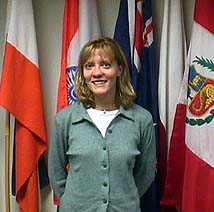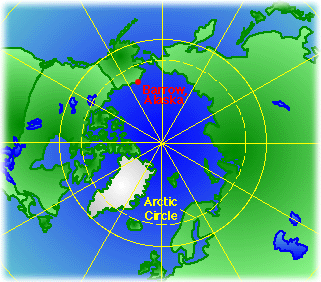
|


Teaching science in Hawai'i has meant that my own need and
desire to learn has only increased since leaving college. Since the
Hawaiian archepelago is the most isolated chain of islands in the world,
flora and fauna have evolved here that are found no where else. It also
has the unfortunate distinction of being the endangered species capital
of the United States. This makes my arctic research experience on a
threatened species of sea duck, the Steller's Eider, even more
applicable when I return to the classroom.
Wai'anae is 40 miles from Honolulu - a long distance when you
are on an island! Therefore, the biggest form of entertainment around
here is ocean related. I like to snorkel, swim, TRY to surf, SCUBA
dive, fish, as well as read, run, and hike. I am lucky to have the
opportunity to teach Biology and Chemistry for the Hawaiian Studies students this coming school year, which means I get to spend all day on
Thursday up in the leeward mountains with them! I will also have 3 9th
grade Earth Science classes, so I am excited that during this summer
session, an Earth Science teacher (Mr. Steve Petty) has agreed to follow
my adventures with his class, and hopefully we can build on the
activities for the coming school year.
Mahalo (thank you) for following along on my trip up north. My
parents have mailed me my wool sweaters and socks so I am all packed and
ready to go! :-D The Steller's Eider (Polysticta stelleri) is the smallest of the four eider species, all of which can be observed in coastal regions of Alaska and Russia. Steller's Eiders breed on the arctic coastal plane of Russia and Alaska, including the area near Barrow, Alaska. In fall, Steller's Eiders flock to the Aleutian Islands, where they molt their feathers, becoming flightless for several weeks, and spend the winter foraging on mussels in the Bering Sea and Pacific Ocean. In summer, Steller's Eiders return to coastal tundra where they forage on insect larvae in freshwater lakes and ponds. Steller's Eiders were once common in Alaska, but in 1997 they were admitted to the United States list of threatened species. Nearly a decade of research on Steller's Eiders in Alaska has shown that these sea duck breed regularly in only one region of the U.S., the area near Barrow, although nesting eiders are observed only in some years. Since 1991, Robert Suydam and his colleagues have found a correlation between fluctuations in lemming populations near Barrow and nesting in Steller's Eiders. It appears that Steller's Eiders nest only in years when lemmings are abundant. Lemmings are a common prey species for Snowy Owls, Pomeraine Jaegers and Arctic Foxes. Abundant lemmings bring nesting owls and jaegers to the tundra, where eiders also nest. Arctic Foxes frequently prey upon the eggs of nesting birds, but owls and jaegers are vigorous defenders of their nests. The small-bodied eiders benefit from the vigilant efforts of nesting owls and jaegers driving foxes away; furthermore, foxes may be less likely to target nests when lemmings are available. Researchers are still puzzled over the disappearance of Steller's Eiders from the Barrow area in some years and the apparent lack of nesting eiders in low lemming years. The continuation of research on Steller's Eiders that began earlier this decade will examine the use of habitat for nesting outside of the original study area. Scientists will also concentrate on learning more about the reproductive biology of Steller's Eiders, including incubation time for eggs. Nest locations are discovered by walking across the tundra until a female flushes from her nest. Researchers mark the nest with an assigned number and map its location, then measure the length and width of the eggs. In some nests, they will place a temperature probe that records the nest bowl temperature every minute for several weeks. The date that the nest was initiated may be known by observation and it can be estimated by looking at the development of the embryo in the egg using a technique called candling. The outline of the embryo can be seen which allows researchers to calculate back to an estimated date of laying. Information on the known date of egg laying, the estimated date of egg laying, nest bowl (incubation) temperature, and hatch date, determined from subsequent visits, will result in the determination of incubation time for Steller's Eiders. Data collected on egg sizes, nest success, and other parameters will help fill in details of Steller's Eider natural history, breeding biology, and population ecology.
Populations of Steller's Eiders, King Eiders and Spectacled Eiders have
declined dramatically in Alaska over the last decade. Research on the
habitat use, breeding biology, and continued population monitoring is
necessary to learn the cause of the population decline and prevent these
and other waterfowl species from disappearing entirely.
September 1999
June 1999
May 1999
|




